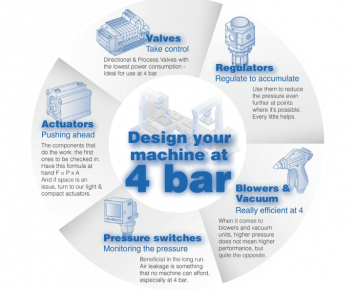- Home » Editorial » Pneumatics
Helping OEMs develop energy-efficient machines

Roy Schep, Manager Energy Efficiency, SMC Netherlands, looks at how tohelp OEMs develop energy-efficient machines.
OEMs traditionally design their pneumatic machinery and equipment for an operating pressure of 7 bar. However, by reducing this to 4 bar, I know from experience that end users can cut their energy costs by up to 29% in some instances, creating a powerful USP for the OEM.
The shift to 4 bar standard operating pressure is already taking place at some large manufacturing companies. While not seeing mainstream adoption just yet, we believe it will become standard practice in the not-too-distant future as regulations tighten and public pressure for more energy-efficient industry grows.
With this thought in mind, OEMs must begin preparing for a 4 bar landscape. By making the transition now they can become industry pioneers, not only helping to capture a larger share of a rapidly emerging market, but significantly boosting their corporate image. Sure enough, while this task may at first appear daunting, working with the right technology partner can help ensure a painless changeover.
Although the vast majority of machine components will still perform at 4 bar, we should of course keep a close eye on some of them to ensure they operate as intended.
Actuators: pushing ahead
When designing a machine from scratch, it makes sense to start with the components that do the work: the actuators. In general terms, these are the elements that may not perform at their best, or sometimes not at all, using lower pressure.
Two variables are key: force and speed. In my experience, actuators in the majority of horizontal applications operate at lower supply pressure because they are only acting against friction, not force. As a result, it’s normal to size actuators for use in horizontal orientations to perform at a certain speed.
In vertical applications, however, the story can be different as the cylinder pressure has to overcome the load pressure. These applications tend to be more critical and usually demand specific considerations to ensure the actuator meets its intended objective. Reducing the pressure to 4 bar in vertical applications may require the use of a larger bore actuator to ensure the required force. If using a larger bore size is an issue due to lack of space, SMC’s VBA series pressure boosters can provide the required pressure level in that local part of the application without having to increase the main line pressure, making it possible to use the existing actuator size.
In either case, a simple calculation can indicate the theoretical force of the cylinder: F= P x A, where F is force in Newton, P is pressure in bar and A is the effective area of the cylinder bore in cm2. As a point of note, if working at 4 bar demands a larger bore size, the saving in air consumption will offset any additional cost.
-
PPMA 2025
23 September, 2025, 9:30 - 25 September, 2025, 16:00
NEC, Birmingham UK -
Advanced Engineering Show 2025
29 October, 2025, 9:00 - 30 October, 2025, 16:00
NEC, Birmingham UK










